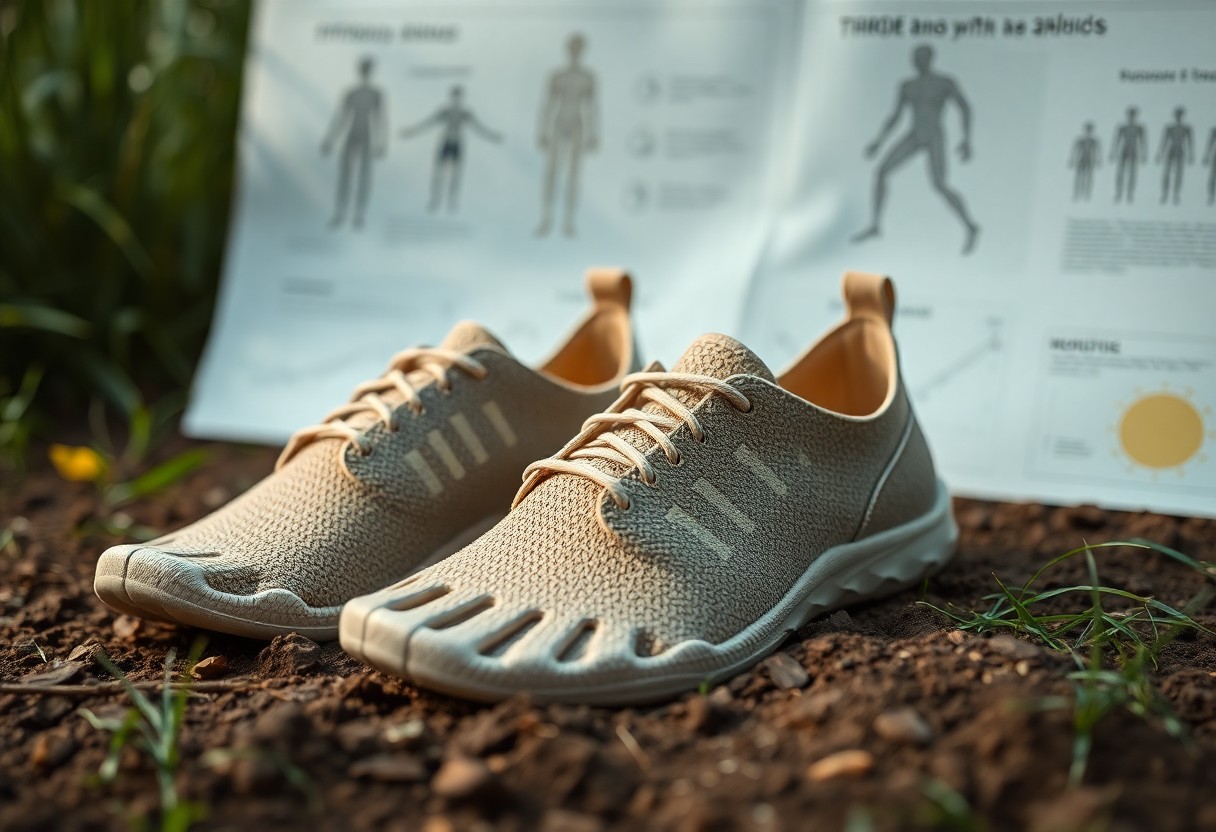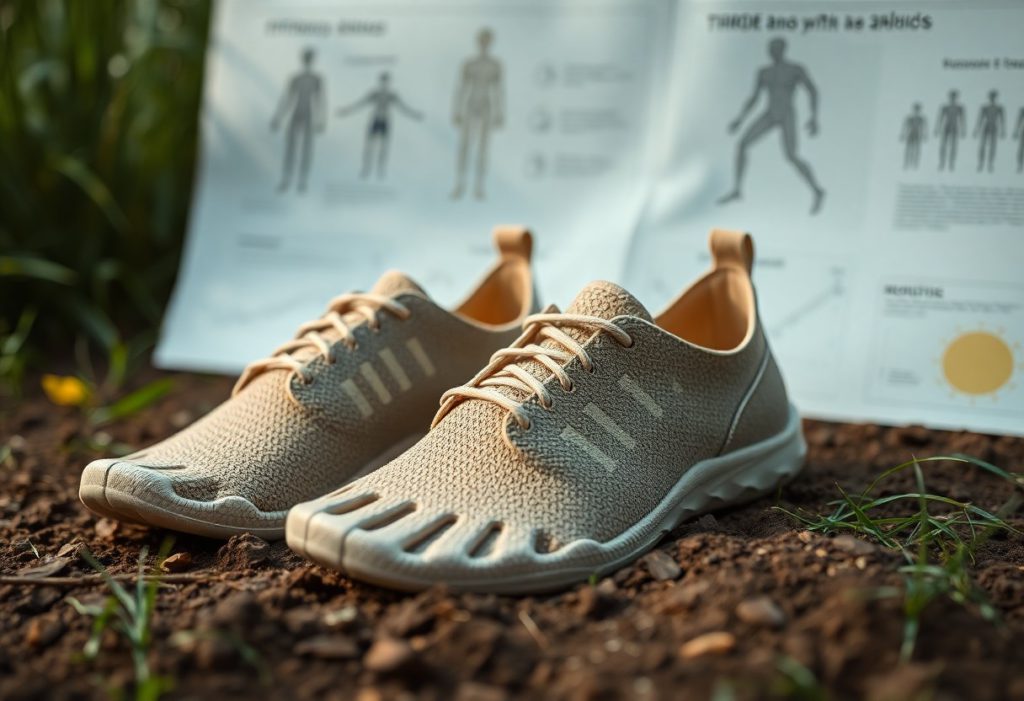Adopting sustainable design principles in the footwear industry is not just about minimizing waste; it also plays a crucial role in enhancing foot health. <a href="https://myshoesfinder.com/barefoot-shoes-comfort-for-teachers-all-day/">Barefoot shoes</a> are leading a transformative shift in this sector by significantly reducing CO₂ emissions through innovative materials and efficient manufacturing techniques. By opting for these environmentally friendly designs, you're making a conscious choice to contribute to a future where <a href="https://myshoesfinder.com/xero-xbplus-smartshoe-ces-2025-review-running-optimization/">biomechanical optimization</a> aligns seamlessly with environmental responsibility. Become part of the expanding community that prioritizes footwear that not only enhances your physical wellness but also nurtures our planet. Thorough lifecycle assessments reveal how minimalist shoe designs can significantly lower your carbon footprint, positively affecting both your personal health and the environment.
Revolutionizing Footwear Manufacturing for a Greener Future
To truly transform footwear manufacturing, it is imperative to implement creative strategies that effectively reduce the environmental impact associated with this industry. Given the considerable contributions of the footwear sector to global CO₂ emissions, it is essential to adopt sustainable practices that emphasize ecological balance while also prioritizing consumer health. By concentrating on advanced material sourcing, enhancing manufacturing efficiency, and crafting effective end-of-life management strategies, the footwear industry can make substantial strides in diminishing its carbon footprint. This transition not only promotes environmental health but also meets the rising consumer demand for responsible and sustainable products.
Utilizing Cutting-Edge Materials for Enhanced Sustainability
Innovative brands are proactively embracing disruptive material innovations to drastically minimize their environmental impact. For instance, Xero Shoes’ dedication to using materials such as hemp and recycled PET not only reduces production emissions by an impressive 32% but also aligns with the growing consumer demand for sustainable products. This strategic transition not only safeguards local ecosystems but also fosters a circular economy by actively decreasing waste throughout the production cycle. By focusing on these sustainable materials, brands can bolster their environmental stewardship while appealing to a conscientious consumer base that values eco-friendly practices.
Conducting Lifecycle Analyses to Uncover Carbon Footprint Reduction Strategies
Engaging in comprehensive lifecycle analysis is vital for accurately evaluating the overall carbon footprint of footwear products. By investigating each stage—from material sourcing and manufacturing to usage and eventual disposal—you can identify critical areas that require improvement. For example, the typical emissions associated with barefoot shoes range from 10-20 kg CO₂e per pair, showcasing an impressive 40% reduction compared to conventional athletic footwear. Initiatives like Vivobarefoot’s ReVivo program, which prolongs the lifespan of shoes and reduces emissions to just 5.8 kg CO₂e, illustrate the significant advantages that sustainability measures can provide regarding production efficiency and consumer appeal.
Boosting Foot Health Through Biomechanical Principles and Barefoot Design
The integration of biomechanics into barefoot shoe design amplifies the numerous benefits associated with minimalist footwear, resulting in notable improvements in both foot health and sustainability. By prioritizing natural foot movement, these shoes enable your feet to function as intended, leading to improved posture and a lower risk of injuries. The lightweight construction of barefoot shoes encourages a more effective gait, ensuring that each step feels more comfortable and less taxing on your body. This not only contributes to your personal well-being but also aligns with a commitment to ecological sustainability, as every step taken in these shoes reflects a dedication to both health and environmental consciousness.
Enhancing Gait and Movement Through Minimalist Shoe Designs
Minimalist designs found in barefoot shoes encourage a natural gait that promotes midfoot or forefoot striking patterns. This adjustment can lead to a significant reduction in the impact force on your joints, resulting in a more efficient and pleasurable walking or running experience. By eliminating excessive cushioning and support, these shoes allow your foot muscles to engage fully, fortifying the intrinsic musculature essential for optimal movement. This natural footwear approach not only boosts your physical performance but also cultivates a deeper connection with the ground, enriching your overall physical activity and enhancing your engagement with the environment.
Exploring Energy Efficiency in Movement: Insights from Recent Scientific Research
Recent scientific investigations underscore the vital role of energy efficiency in the performance of barefoot shoes. Studies have shown that runners who wear barefoot footwear experience a notable enhancement in energy return and propulsion mechanics, resulting in reduced fatigue and a more sustainable running style. This directly benefits your movement efficiency during extended activities, making each step more productive. The improved energy efficiency is deeply rooted in the thoughtful design of barefoot shoes, which support better biomechanics. For example, trials involving 15 participants revealed that those wearing minimalist shoes made from algae-foam materials reported an energy return rate of 89%, compared to just 82% for traditional EVA foams. This dynamic nature of barefoot footwear facilitates a more natural range of motion, significantly alleviating knee stress during various activities. By capitalizing on these advantages, barefoot shoes emerge not only as an environmentally responsible choice but also as a groundbreaking solution for achieving optimal energy efficiency in movement.

Current Consumer Trends: Insights into the Demand for Eco-Friendly Footwear
Understanding consumer motivations is crucial for facilitating the widespread acceptance of sustainable footwear. Today’s consumers increasingly prioritize ecological and health benefits, gravitating towards products that meet their functional needs while aligning with their personal values regarding environmental stewardship and overall well-being. As awareness of sustainability continues to grow, buyers are actively seeking footwear brands that embody these essential principles, reflecting a broader shift in consumer behavior.
Recognizing Eco-Conscious Consumer Trends and Preferences in Footwear Choices
As sustainability solidifies itself as a fundamental value, eco-conscious consumers are on the lookout for footwear brands that resonate with these ideals. Recent data indicates that 43% of shoppers are willing to pay a premium of 30% for sustainably produced shoes, highlighting a significant change in consumer priorities towards eco-friendly materials and ethical practices. This trend emphasizes the increasing significance of sustainability as a critical factor in purchasing decisions, motivating brands to embrace more responsible production methodologies.
Evaluating the Perceived Value of Sustainability in Footwear Purchases
The perception of value surrounding sustainability in footwear is more than a fleeting trend; it significantly influences purchasing decisions. As a discerning consumer, you are likely to be swayed by environmental concerns, health advantages, and assurances of durability, with research suggesting that perceived environmental benefits rank highest among consumer motivations. By choosing sustainable footwear, you’re actively supporting a more extensive movement towards responsible consumption, a sentiment that resonates with many buyers today.
This growing awareness regarding environmental impacts illustrates that consumers appreciate brands prioritizing sustainable features. Such perceptions of value foster stronger brand loyalty and can amplify the effects of your purchasing choices, encouraging manufacturers to invest in greener practices and materials. Ultimately, sustainability enhances a product's perceived worth, aligning your decisions with broader environmental objectives while effectively satisfying your footwear needs.
Understanding the Regulatory Landscape for Sustainable Footwear Innovation
The ever-changing regulatory environment plays a pivotal role in steering the footwear industry towards sustainable innovation. With increasing scrutiny on carbon emissions and environmental degradation, new regulations are being implemented to promote greener practices within manufacturing processes. Complying with these emerging standards not only addresses urgent environmental issues but also aligns with consumer expectations, compelling brands to innovate in a responsible and transparent manner while meeting compliance requirements.
Comprehending Compliance Mandates: Catalyzing Sustainable Practices
New compliance mandates, particularly within the European Union, are establishing the foundation for sustainable practices across the footwear sector. By 2027, regulations will necessitate a minimum of 20% recycled content in footwear materials, while carbon labeling will become mandatory for all athletic shoes by 2026. These guidelines challenge brands to reconsider their material sourcing, production methods, and end-of-life strategies, ensuring greater accountability and environmental stewardship within the industry.
Harnessing Innovation Through Regulation: Opportunities and Challenges Ahead
While new regulations introduce various challenges, they simultaneously unveil innovative opportunities for brands willing to adapt. Embracing compliance mandates encourages companies to invest in sustainable technologies, developing solutions that reduce carbon footprints while enhancing overall product performance. For instance, brands are investigating biodegradable materials and cutting-edge manufacturing techniques that can yield improved durability and reduced waste. However, navigating the complexities of regulatory compliance requires an agile approach, as organizations must balance sustainability aspirations with market demands and cost considerations.
Amidst these complexities, the regulatory landscape fosters a culture of innovation that stimulates the development of new materials and processes. Embracing technologies like 3D printing and bio-based materials not only aligns with compliance requirements but also presents unique branding opportunities that resonate with environmentally conscious consumers. Brands willing to embrace these transformative advancements will distinguish themselves in a competitive market, driving progress while adhering to rigorous environmental standards. By perceiving regulation as an opportunity rather than an obstacle, you can position your brand at the forefront of the sustainable footwear movement.
Imagining the Future of Footwear: Merging Technology with Sustainability
The intersection of technology and sustainability is reshaping the landscape of footwear as we know it. As manufacturers utilize cutting-edge materials and integrate intelligent features, the next generation of footwear promises enhanced performance while simultaneously minimizing environmental impact. Innovations such as 3D printing and smart systems are paving the way for designs that not only meet your foot health needs but also promote ecological integrity. This dynamic shift reflects a deepening commitment to merging functionality with environmental responsibility within the footwear sector.
Incorporating Smart Features in Footwear: Improving User Experience and Eco-Friendly Outcomes
Smart features embedded in footwear significantly enhance your overall experience while contributing to sustainability objectives. By integrating sensors into the design, these shoes can provide real-time feedback on your gait, allowing you to optimize your performance effectively and minimize injury risks. Moreover, these innovations frequently utilize eco-friendly materials, ensuring that your pursuit of athletic excellence aligns seamlessly with your commitment to environmental protection.
Customizing Footwear Through On-Demand Production and 3D Printing
On-demand production leverages 3D printing technology to create shoes tailored specifically to your individual needs. This innovative method not only allows for a personalized fit but also drastically reduces waste associated with traditional manufacturing processes. By utilizing advanced 3D printing techniques, brands can produce footwear that accurately reflects individual foot dimensions based on pressure mapping and other biometric data. This level of customization minimizes the likelihood of returns and excess inventory, with studies indicating a 73% reduction in waste through on-demand manufacturing practices. Additionally, localized production diminishes transportation emissions and bolsters regional economies. As brands embrace this technology, you gain access to shoes that are not only better suited to your feet but also more environmentally responsible.
Become an Advocate for the Sustainable Footwear Movement
In summary, the innovations surrounding sustainable footwear are transforming the industry by aligning biomechanics with environmental responsibility in barefoot shoe design. By incorporating minimalist footwear into your daily routine, you can enhance your foot health while significantly reducing your carbon footprint. Choosing shoes that prioritize sustainable materials and ethical manufacturing practices supports a transformative shift towards a more eco-conscious market. Embracing these advancements not only benefits you personally but also contributes to the broader goal of planetary health, promoting a future where functionality and sustainability coexist harmoniously.
The Article Sustainable Footwear Innovation: Bridging Biomechanics and Environmental Responsibility in Barefoot Shoe Design appeared first on My Shoes Finder
The Article Sustainable Footwear Innovation in Eco-Friendly Barefoot Design Was Found On https://limitsofstrategy.com








